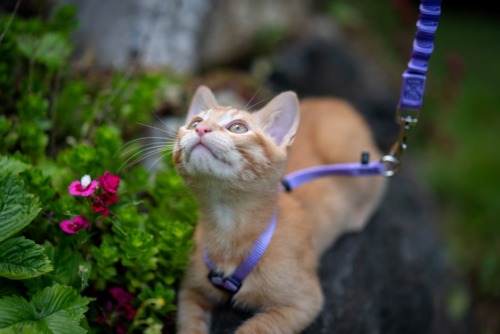
Most cats don’t get much structured time outside. They crave to explore the outdoors, to exercise their instincts and curiosity in a way domestic life can’t quite satisfy. While many still let their cat wander alone for hours a time, leash training has become a more common (and more safe) alternative to roaming unsupervised. Teaching your cat to walk on a leash can be an enriching experience that deepens your bond. Our walker Nathaniel will give us some tips on how to get started getting your cat leash-trained for the first time!
Why can’t I just let my cat outside on its own?
While the idea of walking a cat may seem odd, unsupervised free-roaming is generally not recommended by vets or other experts on cat behavior. Cats who wander alone can end up eating toxic plants, getting injured by other animals, contracting disease, or getting into road accidents, among other very common risks.
Better alternatives to unchaperoned roaming besides leash training are to create a more stimulating indoor environment or an enclosed outdoor space for your cat to explore. At home, you can invest in various cat furniture pieces that allow them to scratch, climb, or hide under. Placing a bird feeder outside the window can become their personal television. Switching up their toys can also help keep them interested: cycle which toys they get to play with during the week and hide the rest away. The same can be done with their treats! If you have access to a backyard, install fencing that your cat can’t climb over or escape through, and supervise them while they’re outside.
However, if you and your cat are up for a rewarding challenge, leash training might be just the thing!
Is leash training right for my cat?
The first question to ask in this process is, does my cat even want to be outside at all? Some cats might have behavioral quirks or anxieties that make going outside overly stressful, so indoor living or limited outdoor time would be best in these cases. Or perhaps, they’re just not interested in going out and are merely natural homebodies. An easy criterion for deciding if leash training is a worthwhile investment is if your cat:
- Wants to be outside
- Is reasonably confident and self-sufficient
- Tolerates handling
- Tolerates noises and isn’t overly nervous
If the list above describes your pet, then consider them ready for leash training!
What to get your cat for leash training:
For walking equipment, you’re going to need a body harness or vest harness that comes in a durable, lightweight material, like nylon. Collars are far too easy for cats to escape from, so a vest or body harness will give them coverage, protection, and comfort.
A fixed-length leash will be best for you and your cat when learning to walk together. Not only will it help build your cat’s confidence and make them feel safe, but a fixed lead will allow you to keep your cat in arm’s reach in an emergency. Some may recommend retractable leashes, but they may become a better option once you and your cat have more experience.
Last on your checklist is the cat’s favorite part of training: the treats! Identify which treats your cat is most excited for and keep a pouch on hand while practicing. Make sure to cut these treats into smaller pieces before your sessions: training grinds to a halt once your cat gets full. With this in mind, plan training sessions around their mealtimes when they’re hungry.
How to leash-train your cat:
In the first phase of training, give your cat time to become familiar with their new harness before putting it on them. Trying to fit a new harness onto a cat before they’re ready can stress them out, reinforce bad associations, and create more challenges before you even begin. Let them investigate their new equipment and support good associations using treats and affection. Let them see you treating the equipment with enthusiasm, as cats can learn by observing their owners: if their human likes it, then it must be good!
Once you get your cat into their harness, get them comfortable wearing it before going on long walks. Lead them around your home, the backyard, or outside the house in baby steps. Reward them with treats and affection for all good behavior and progress. But make sure to reward them quickly! Cats have a working memory of 2-5 seconds, so if you delay their reward, they’ll forget what it was for. Making just a little progress each session will pay off in dividends, even if it’s by just a step more than last time. In general, 15-20 minutes per session is more than enough in the early stages.
Experimenting with different environments can also benefit your cat’s training. Bring them to a park, a hiking trail, or a nature preserve where it’s quiet. In any location, make sure to keep away from off-leash dogs and use the same tactics of retreat and waiting if they get nervous.
What to do if your cat gets scared:
If your cat gets scared during training, stay calm and retreat to a place that feels safe for them. Give them time to rest before trying again. Unless it’s an emergency, resist the urge to pick them up! Your cat needs to walk on their own in order to gain confidence. Picking them up teaches them to depend on you and will ultimately hurt their progress. Showing your cat that you’re not affected will teach them there’s nothing to fear and that they can trust you with their life!
With a little consistency, your cat will be leash-trained and walking outside with you in no time! Getting to see them out in the world will show you a level of autonomy, curiosity, and excitement from your former couch potato that you wouldn’t have imagined possible.
Thank you, Nathaniel, for walking us through how to train cats for a leash! Windy City Paws is a Fear Free Chicago dog walker and petsitter committed to providing helpful information to Chicago dog owners through its blog.
Written for Windy City Paws by Nathaniel F.


